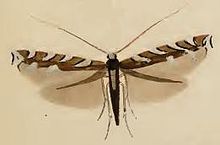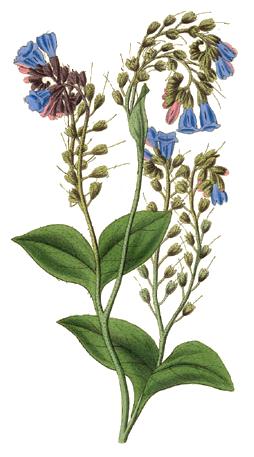
Symphytum is a genus of flowering plants in the borage family, Boraginaceae, known by the common name comfrey. There are 59 recognized species. Some species and hybrids, particularly S. officinale, Symphytum grandiflorum, and S. × uplandicum, are used in gardening and herbal medicine. They are not to be confused with Andersonglossum virginianum, known as wild comfrey, another member of the borage family.

Watercress or yellowcress is a species of aquatic flowering plant in the cabbage family, Brassicaceae.
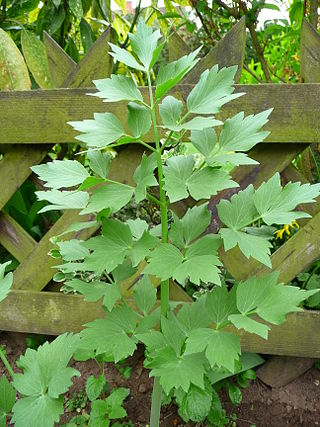
Lovage, Levisticum officinale, is a tall perennial plant, the sole species in the genus Levisticum in the family Apiaceae, subfamily Apioideae. It has been long cultivated in Europe, the leaves used as a herb, the roots as a vegetable, and the seeds as a spice, especially in southern European cuisine. Its flavour and smell are reminiscent both of celery and parsley, only more intense and spicy than either. The seeds can be used in the same way as fennel seeds.

Pulmonaria (lungwort) is a genus of flowering plants in the family Boraginaceae, native to Europe and western Asia, with one species east to central Asia. According to various estimates there may be between 10 and 18 species found in the wild.

Guaiacum officinale, commonly known as roughbark lignum-vitae, guaiacwood or gaïacwood, is a species of tree in the caltrop family, Zygophyllaceae, that is native to the Caribbean and the northern coast of South America.
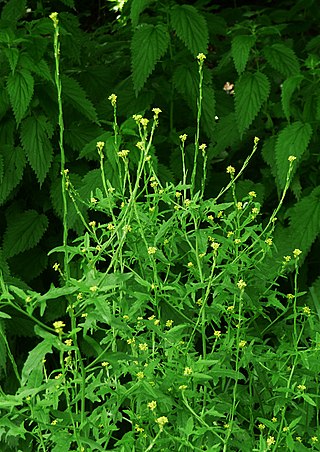
Sisymbrium officinale, the hedge mustard, is a plant in the family Brassicaceae.

Pulmonaria officinalis, common names lungwort, common lungwort, Mary's tears or Our Lady's milk drops, is a herbaceous rhizomatous evergreen perennial plant of the genus Pulmonaria, belonging to the family Boraginaceae.

Rheum officinale, the Chinese rhubarb, or Indian rhubarb is a rhubarb from the family Polygonaceae native to China. In Chinese it is called yào yòng dà huáng, literally meaning medicinal rhubarb.

Taraxacum officinale, the dandelion or commondandelion, is a herbaceous perennial flowering plant in the daisy family Asteraceae. The common dandelion is well known for its yellow flower heads that turn into round balls of many silver-tufted fruits that disperse in the wind. These balls are called "clocks" in both British and American English. The name "blowball" is also used.

Ethmia quadrillella is a moth belonging to the family Depressariidae, subfamily Ethmiinae.

Officinalis, or officinale, is a Medieval Latin epithet denoting organisms—mainly plants—with uses in medicine, herbalism and cookery. It commonly occurs as a specific epithet, the second term of a two-part botanical name. Officinalis is used to modify masculine and feminine nouns, while officinale is used for neuter nouns.

Ethmia pusiella is a moth of the family Depressariidae. It occurs throughout Europe and eastwards to the Tien Shan mountains of eastern Central Asia.
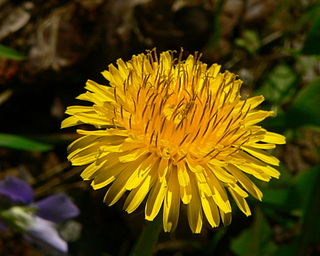
Taraxacum is a large genus of flowering plants in the family Asteraceae, which consists of species commonly known as dandelions. The scientific and hobby study of the genus is known as taraxacology. The genus is native to Eurasia and North America, but the two most commonplace species worldwide, T. officinale and T. erythrospermum, were introduced from Europe into North America, where they now propagate as wildflowers. The plant thrives in temperate regions and can be found in yards, gardens, sides of roads, among crops, and in many other habitats. Both species are edible in their entirety and have a long history of consumption. The common name dandelion is also given to specific members of the genus.

Hemaris gracilis, the slender clearwing or graceful clearwing, is a moth of the family Sphingidae. The species was first described by Augustus Radcliffe Grote and Coleman Townsend Robinson in 1865.

Lobaria pulmonaria is a large epiphytic lichen consisting of an ascomycete fungus and a green algal partner living together in a symbiotic relationship with a cyanobacterium—a symbiosis involving members of three kingdoms of organisms. Commonly known by various names like tree lungwort, lung lichen, lung moss, lungwort lichen, oak lungs or oak lungwort, it is sensitive to air pollution and is also harmed by habitat loss and changes in forestry practices. Its population has declined across Europe and L. pulmonaria is considered endangered in many lowland areas. The species has a history of use in herbal medicines, and recent research has corroborated some medicinal properties of lichen extracts.

Jasminum officinale, known as the common jasmine or simply jasmine, is a species of flowering plant in the olive family Oleaceae. It is native to the Caucasus and parts of Asia, also widely naturalized.

Euchalcia modestoides is a moth of the family Noctuidae. It is found from the temperate areas of central Europe, east to Japan.

Coleophora pennella is a moth of the family Coleophoridae. It is found in most of Europe.
Coleophora pulmonariella is a moth of the family Coleophoridae. It is found from Sweden and northern Russia to the Pyrenees and Italy, and from France to Romania.

Cynoglossum germanicum, the green houndstongue, is a flowering plant species, in the family Boraginaceae, which is native to Europe.
